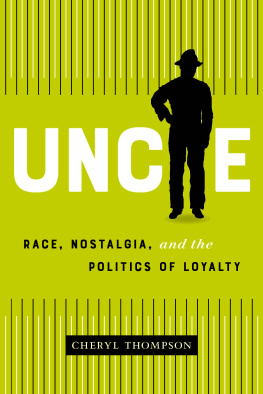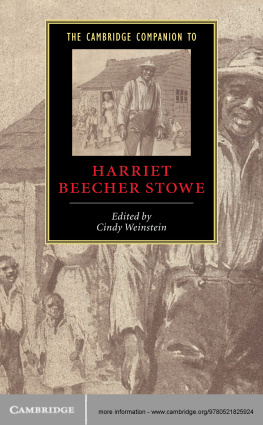Table of Contents
Landmarks
List of Pages
UNCLE
RACE, NOSTALGIA, and the POLITICS OF LOYALTY
CHERYL THOMPSON
COACH HOUSE BOOKS, TORONTO
copyright Cheryl Thompson, 2021
first edition

Published with the generous assistance of the Canada Council for the Arts and the Ontario Arts Council. Coach House Books also acknowledges the support of the Government of Canada through the Canada Book Fund and the Government of Ontario through the Ontario Book Publishing Tax Credit.
LIBRARY AND ARCHIVES CANADA CATALOGUING IN PUBLICATION
Title: Uncle : race, nostalgia, and the politics of loyalty / by Cheryl Thompson. Names: Thompson, Cheryl, 1977- author.
Identifiers: Canadiana (print) 20200155393 | Canadiana (ebook) 20200155407 | ISBN 9781552454107 (softcover) | ISBN 9781770566316 (EPUB) | ISBN 9781770566408 (PDF)
Subjects: LCSH: Uncle Tom (Fictitious character) | LCSH: Stowe, Harriet Beecher, 1811-1896. Uncle Toms Cabin. | LCSH: African Americans in popular culture. | LCSH: African Americans in mass media. | LCSH: African AmericansSocial conditions. | LCSH: Stereotypes (Social psychology)
Classification: LCC PS2954.U6 T46 2021 | DDC 813/.3dc23
Uncle: Race, Nostalgia, and the Politics of Loyalty is available as an ebook: ISBN 978 1 77056 631 6 (EPUB), ISBN 978 1 77056 640 8 (PDF)
Purchase of the print version of this book entitles you to a free digital copy. To claim your ebook of this title, please email with proof of purchase. (Coach House Books reserves the right to terminate the free digital download offer at any time.)
TABLE OF CONTENTS
INTRODUCTION
I love old movies and I love watching Turner Classic Movies in particular. One Saturday evening a few years ago, I stumbled upon The Great White Hope. Released in 1970, it stars James Earl Jones as boxer Jack Jefferson. The film is a biopic based on the life of boxer Jack Johnson (18781946), who, at the height of the Jim Crow era, became the first African American world heavyweight champion; he held the title from 1908 to 1915. I have been a huge boxing fan since I was a little kid. I first discovered Johnson when I was a teenager, but learned more about his life only when I was teaching a Black Studies course at the University of Toronto. I devoted an entire lecture to the history of Black people in sports. Johnson was truly the first African American sports hero. Yet he was also a controversial figure because he crossed racial and class lines in both his professional and personal life, even marrying a white woman, Etta Terry Duryea (played in the film by Jane Alexander), at a time when interracial relations were not only frowned upon but could result in death by lynching.
At one point in the film, Jefferson is in Budapest shortly before the start of World War I, but not to box. Instead, he is there to take the stage in a cabaret performance of Uncle Toms Cabin. It was an unexpected reference in a film about a boxer, and one I knew something about. Because I have been obsessed with Uncle Toms Cabin ever since I started studying the phenomenon of the nineteenth-century novel and its subsequent spinoffs. When several characters from Uncle Toms Cabin appeared as part of the films storyline, I had an aha moment.
 Title-page illustration by Hammatt Billings for
Title-page illustration by Hammatt Billings for Uncle Tom's Cabin
[First Edition: Boston: John P. Jewett and Company, 1852].My fascination with the novel, first published in 1852 by Harriet Beecher Stowe, began in my twenties, when I read the book for the first time. I was working then as an insurance claims adjuster, living in a suburb northwest of Toronto. I had heard about the book since I was a little kid. But after someone I knew was called an Uncle Tom, I decided I needed to know where this term came from. Out of sheer curiosity, I began reading the 391-page novel on the commuter train into the city. It took me almost a year to get through it, because nineteenth-century novels are pretty dense. But after I finished, I felt like I had just hit the tip of the iceberg in terms of understanding why, of all the character names in fiction, Uncle Toms has lingered on in popular culture and politics.
Uncle Toms Cabin interweaves three narratives. The first is the story of Eliza, an enslaved woman who becomes a fugitive when she flees with her young son over ice floes on the Ohio River to Cincinnati. With the help of Northerners, and in defiance of the 1850 Fugitive Slave Act a federal law that mandated the capture and return of African Americans into slavery, whether they were enslaved or free Eliza heads to Canada to reunite with her husband, George, who had run away earlier, refusing to endure his masters cruelty any longer.
The other two storylines involve Uncle Tom and Little Eva. Tom, whom Stowe depicted as a dignified Christian man in his thirties or forties, is born a slave on a Kentucky plantation owned by Mr. Shelby. After falling into financial trouble, Shelby is forced to sell two of his slaves, one of whom is Tom. Even though Tom has a wife and children, he is sold to a slave dealer named Mr. Haley, who takes him to New Orleans. While being transported by boat to the plantation, Tom rescues another passenger, Little Eva St. Clare, a six-year-old who has fallen into the river. Her grateful father, Augustine St. Clare, agrees to purchase Tom at auction.
Once on St. Clares plantation, Tom and Eva become friends. Tom takes on the role of Evas surrogate father, but also her plaything. He comforts and consoles Little Eva but does not scold or discipline her. In the early illustrated editions of the novel, Tom and Eva are depicted sitting together in an arbour on the plantation, reading the Bible. In other images, Eva sits on Toms lap and helps him get dressed.
Eva is a sickly child. She falls ill and, on her deathbed, asks her father to free all his slaves, especially Tom who is depicted in illustrations as a dutiful friend at Evas deathbed.
Topsy, the young, enslaved girl in the novel, is a dehumanized depiction of Black girlhood. She is the extreme opposite of Little Eva, the novels child-angel. Topsy has unkempt hair, she lies, and is frequently in need of discipline. The juxtaposition between Topsy and Little Eva sets the stage for two racial stereotypes that still linger today around white childhood innocence and the far less innocent depictions of Black childhood.
While St. Clare is preparing to free his slaves, he is unexpectedly killed in a fight. Simon Legree, who owns a plantation in a remote area of Louisiana, purchases Tom and St. Clares other slaves from the estate. Legree is a brutal figure. He beats Tom for refusing to abuse the other enslaved men and women. Finally, Legree whips Tom to death after he refuses to reveal the whereabouts of others who have run away. Uncle Tom is the novels heroic figure because he chooses not to escape. Instead, he accepts his suffering and becomes Stowes martyr a simple, God-fearing Christian whose strong faith does not allow him the apparently selfish luxury of escape. Tom ultimately becomes a symbol for a pious Black masculinity that is non-violent, loyal, and even accepting of the status quo for enslaved people.
Stowes story profoundly influenced public attitudes about slave-holding and the Fugitive Slave Act, as well as the events leading up to the Civil War. President Abraham Lincoln is reported to have said that Stowe and her book helped precipitate the Civil War. Early readers could not have known that







 Title-page illustration by Hammatt Billings for Uncle Tom's Cabin [First Edition: Boston: John P. Jewett and Company, 1852].
Title-page illustration by Hammatt Billings for Uncle Tom's Cabin [First Edition: Boston: John P. Jewett and Company, 1852].